by tmoffett | May 17, 2012 | Color, Composition, Photographic Philosophy
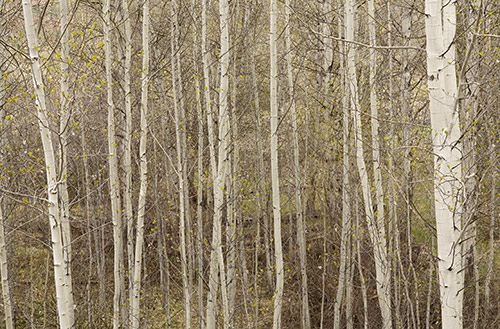
Aspens, Sun Valley, Idaho
Part of my job as a photographer is to simplify the chaotic world that we live in so that the images created in my camera are easy and interesting to look at. Most of the time, the scenes that present themselves to us are filled with so much “stuff” that it is hard to isolate individual elements. If we don’t train ourselves to look for simplicity, we will rarely find it. I often tell my students that I see the world better than they do because I see differently. I have looked so long for small elements that interest me that that is now what I see. My photographs are my vision. That is how I see the everyday world.
Composition is critical to creating interesting images. Painters, I think, have the advantage here because they start with a blank canvas and add only those elements that are needed for the image. Photographers, on the other hand, must find those compositions in nature, and then capture them in the camera. One afternoon as I was walking along the river in Sun Valley, I happened upon this aspen grove. When you look into the photograph, there is a lot going on, however as I looked and thought about what it was that made me stop, I realized that the repeated vertical lines of the tree trunks are what interested me. The muted color and tones created by a late afternoon overcast sky enhanced a feeling of peace and calm. Given the time, I could sit in the middle of this grove in meditation for hours and not feel bored. The strong vertical lines of the trees give my eyes a pattern to follow and places to rest after wandering throughout the other areas of the photograph.
I love finding images that seem to create order out of chaos. My vision is a very simple vision, and in the fast paced society in which we live, visualizing the simple things slow life down for me and helps me to live a more relaxed life.
by tmoffett | May 15, 2012 | Color, Composition, Landscape, Photographic Philosophy
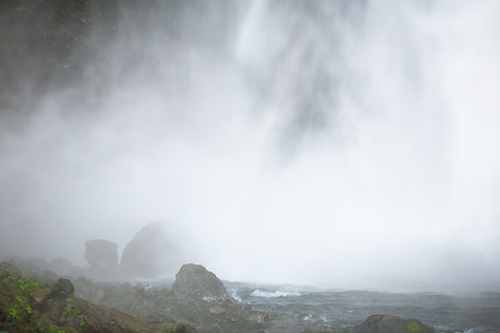
Impact Zone, Multnomah Falls
When traveling to the Northern Oregon Coast I will frequently stop at Multnomah Falls, a very popular and spectacular waterfall that is right next to the highway. I find it interesting that even though I have stopped and photographed this waterfall on numerous occasions, I have never printed an image of the entire falls. I am, for some reason, drawn to the details of this amazing display of water power. This past trip through the Columbia River Gorge was no different. I hiked up to the bridge that provides a great view of impact zone, the area where the falling water meets the pool below. It was fascinating to me. I stood watching as the spray of cold water soaked me and my gear to the bone. I realized what it was I needed to photograph. The trouble was figuring out how to keep my lens dry enough to get the image.
I set up my camera on the tripod and, not worrying at first about getting wet, framed up the image. I needed to capture the falling water at the edge of the frame with the spray and mist blowing through the frame to the left side, causing a thick haze across the entire frame. After framing it up and calculating the needed exposure to show the texture of the falling water in the background and create the desired haze in the foreground, I dried the lens and, with the help of my wife, kept the lens covered until just prior to tripping the shutter, then immediately after the exposure, covered the lens again. About every third shot, I stopped to dry off the lens again. It was quite a challenging process, however very rewarding as well.
Masterpieces are very rarely created in an easy setting. I believe that it is the challenges that allow us to create great images. In photography, just as it is in life, anything worth doing is worth working for. In conditions where everyone else packs it in and goes home, he who perseveres is bound to create something great. It is that challenge that I am constantly striving for. That is one reason that when I saw the forecast for heavy rain I opted to go to the coast. I knew that the adverse conditions would force me to look at things a little differently than I had in the past. I would attack the situation head on and was confident that I could win. I certainly was glad that I did as I returned home with a few great images added to my portfolio.
by tmoffett | May 10, 2012 | Color, Landscape
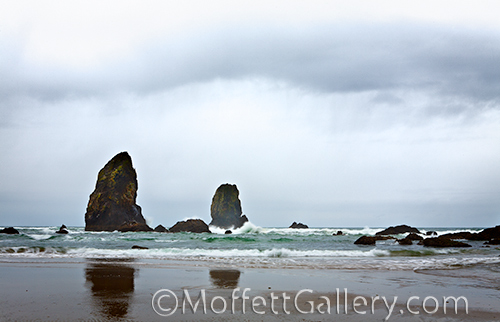
Rainstorm at the Needles
I can’t say that I love cold and rainy weather, but I do love how a good storm can create a mood. Last week as I was on the Oregon Coast, we had rain every day, and it wasn’t Idaho rain, this was real rain. It was tempting at times not to go out in the elements, as I was on a relaxing vacation, not really a working photography trip. However, every time I had the thought to stay in, thoughts of the different look I could get if I ventured out entered my mind and I was easily persuaded to photograph in the rain. I am very glad I did, as I was able to add a few images to my Oregon portfolio that have a much different feel to them than those that I had previously made.
When photographing in adverse conditions, it is so important to really have a command of the medium. Knowing what effect different shutter speeds will have on an image when the rain is coming down and the wind blowing is really not something that you want to have to think about. By the time you have thought about it, it is too late. The whole scene may have changed. I want to be able to quickly evaluate a scene and make fast decisions as to how to capture the feeling that I want to portray, set the camera and move on. In these situations I was fortunate to have my wife with me as an assistant, holding an umbrella or doing whatever was necessary to keep my equipment as dry as possible. This is not an easy task when the rain is blowing horizontally, but she did a fantastic job. I focused on making images while she focused on keeping us dry. It was a great combination that allowed me to make a few wonderful images.
by tmoffett | May 8, 2012 | Color, Landscape
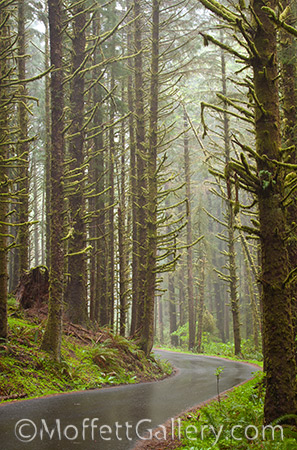
Rainstorm, Ecola State Park
It is always good to be back home. After a 5 day trip to the Oregon Coast, we arrived home yesterday. I love Oregon. It is one of my favorite places to travel to and photograph. However, as much as I love Oregon, Idaho is my home, and I live returning home.
The work from the trip is now just beginning. I have started sorting images and determining what will be printed. Then the processing and prep work. Proofing, re-edit and then on to the final prints. It is an enjoyable process for me. I have always loved the entire process of photography. It is a lot of work, but very rewarding. I cannot see myself doing anything else.
The image above is one of the many potential prints from this trip. It was taken in Ecola State Park during a major rainstorm. It rained most of the week and was cold. Even in these adverse conditions, however, the photography was most enjoyable. Oftentimes the storms bring great opportunities to create great photographs, if a person is willing to brave the weather. I have many students who are afraid to take their cameras out in the weather, but with a little preparation they would have many great opportunities that would otherwise be lost. Covering the camera with a plastic bag is an easy and cheap way to keep equipment dry. My favorite method, however is to have my wife be my assistant and carry an umbrella that will keep both me and my cameras dry. That is how I worked most of the week. It was wonderful, and we made some great photographs.
by tmoffett | May 1, 2012 | Color, Landscape, Ramblings
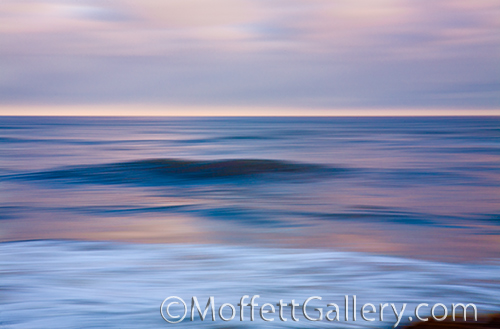
Horizon from Devils Churn
I love the ocean. I’m not sure how I fell in love with it, but I did. I grew up in Utah and have lived in Idaho for the past 20 plus years, but somewhere along the way I found the ocean. Every chance I get, I head to the sea, most frequently to the Oregon Coast is my destination of choice. I love the smell, the sights, the sounds. Waves crashing into a rocky shoreline or sitting on a sandy beach. It is all good to me. I can sit and watch the waves for hours and never tire of the experience.
While observing and experiencing the ocean, I am often drawn to the horizon, that line where sea and sky meet. There are times that it is nearly invisible, as the two blend almost seamlessly together, and at other times there is a distinct line. The reflection of colors bouncing off the water, blending in very abstract ways, depending on the wave action is fascinating to me as well. The longer I sit, the more I realize there is to see. The more I attempt to photograph my vision, the more I realize that my vision is very fluid. I see differently, depending on my circumstances. It keeps me coming back for more. And every time I do, I am not disappointed.
by tmoffett | Apr 26, 2012 | Color, Family, Landscape, Ramblings
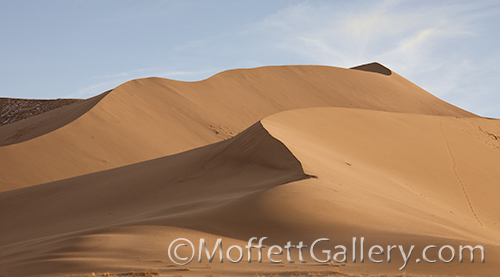
Bruneau Sand Dunes
Sometimes it is nice to just sit back and chill. I have realized that it is a necessity occasionally. Life moves way to fast and will get us down if we don’t take time for ourselves. It is refreshing.
Last month I had a chance to do just that. My wife and I took a weekend and headed out with no plan in mind. I did throw in my camera, but had no intentions or expectations. We just drove. We talked. No kids or responsibilities for a couple of days. It was wonderful. I returned with a renewed spirit and zest for life. It made me a better person and a better artist.
We drove southeast and, as the sun was nearing the horizon we came to Mountain Home, which is not far from Bruneau Dunes State Park. Christeena had never been there, so we decided to stop. It is reported that the taller dune is the tallest single-structured sand dune in North America, rising approximately 470 feet above the lake at its base. We arrived as the sun hit the horizon, so we did not have time to really look and seriously photograph, so we just walked around in the sand enjoyed the view. We had a great time!
by tmoffett | Apr 24, 2012 | Color, Composition, Landscape
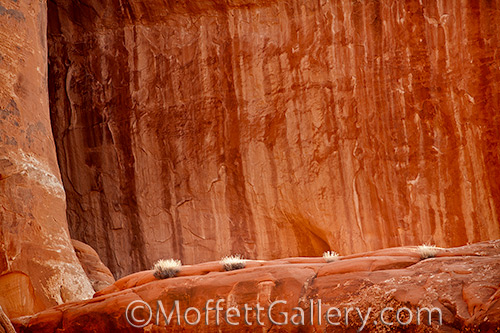
First Light, Arches National Park
One of the hardest principles of good composition to teach is that of simplicity. Elimination of everything in the frame that does not enhance the image creates a composition that will have much more power and impact on the viewer. Slowing down is the key. In today’s world, we are so used to multi-tasking that slowing down and simplifying anything is against our nature, yet doing so, I have found, allows me to enjoy life so much more. I see differently when I take the time. My vision becomes more clear. My photographs become more powerful.
This is an image that I made while at Arches National Park recently. I had hiked in to Landscape Arch in the dark in order to be there for sunrise. As the sky grew lighter, I turned around and this is what I saw. It was not what I had come for, but was a pleasant surprise. These four plants, catching the first rays of morning light as they grew out of solid rock were a better composition and much more powerful and meaningful than the arch I had come to photograph. So many times I have hit my own “Brick Wall” and wanted to give up, but persevering, stretching and growing, I was able to overcome and move forward, much like these plants in this sandstone environment. There are many images in nature that when simplified, can relate to our own lives. Parallel meanings are often hid behind confusion, that when we slow down, become observant and eliminate the excess, we will find. When we do, our art becomes powerful.
by tmoffett | Apr 19, 2012 | Color, Composition, Critique, Landscape, Photographic Philosophy
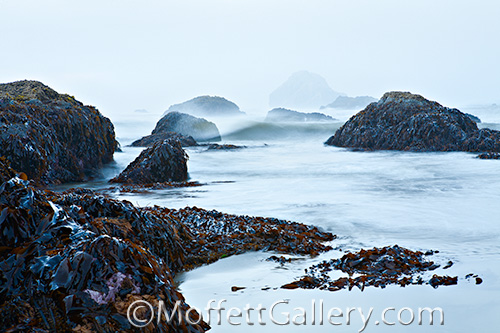
Shoreline at Bandon, Oregon
This happens to be one of my favorite images that I have made along the Oregon Coast. It was a cool, breezy morning and the marine layer was thick, which meant that I would have no dramatic sky. On the coast that is not unusual. I really like what happens here, though. The fog allows for the ocean to appear to vanish into the sky, creating a vastness that otherwise may not be apparent. The thick fog and bluish color of the image helps in creating a coolness, resembling my feelings as I photographed. My images are always about my feelings. It may be what I see, but even more about how I see and what I feel. This particular morning I was cold and wet as I walked the beach in search of an image. I knew, as I walked around the rocks to this location, that I had found what I was looking for. I must have spent 30 minutes or more just watching and dodging the waves as they rushed ashore, finding the correct angle for the composition that said what I wanted and timing the exposure to capture the motion of the water, creating an image resembling the feelings inside of me. When everything comes together as it did here, I am amazed at what can happen.
Photography is really not about the final image, it is about the experience, living the experience and then sharing it through the photographs created.
by tmoffett | Apr 17, 2012 | Color, Family, Landscape
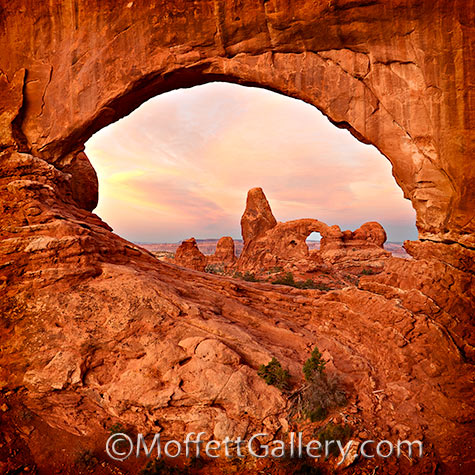
Turret Arch through the North Window
Photography has been a major aspect of my life for a long time. I took photography classes in high school. I studied photography in college, receiving a BFA with a photography emphasis from Utah State University. I have worked as a custom printer, owned my own high end portrait studio for nearly 20 years and now teach photography for a living while pursuing my own fine-art photography passion. As far as a career field, it is all I know.
Arising early in the morning, long before most have even considered rolling out of bed, in order to be at a predetermined location to witness and photograph in the sweet light of sunrise is not a sacrifice for me, it is an opportunity! On my most recent trip to Moab, Utah, it was not uncommon to leave the hotel at 5:00 AM, drive to a destination and hike in the predawn darkness to get where I needed to be for the sunrise. The brisk, early Spring temperatures were quite refreshing. The lack of crowds that fill the parks during the daytime hours was wonderful. Working alone gives plenty of time for reflection and renewal of spirit. On occasion I would meet one or two others searching for the same thing as me. The morning I photographed Turret Arch was one of those occasions. I got a little late of a start that morning, so I was in a hurry to get to the North Window. While carrying nearly 40 pounds of gear, I rushed up the trail, realizing then just how out of shape I was in. I went through the arch and then began to scramble up the rock to a small ledge that allowed me this view of Turret Arch. I was the second photographer in search of that location, and thankfully the one already there was able to direct me to the easiest route up the rock. We shared a very pleasant morning and witnessed a wonderful sunrise. I continued photographing in the area for about an hour, then as the light became harsher I returned to the hotel in time for breakfast with my family.
Following breakfast, I spent the day with my wife and kids enjoying the incredible scenery in the area. We visited the National parks in the area together during the day, hiking in to several arches, picnicking together for lunch and then finding locations to view and photograph the sunset together in the evening. There really is no better life that I could imagine. Family, photography and nature. Life is good!
by tmoffett | Apr 12, 2012 | Color, Landscape, Photographic Philosophy, Photographic Technique, Uncategorized
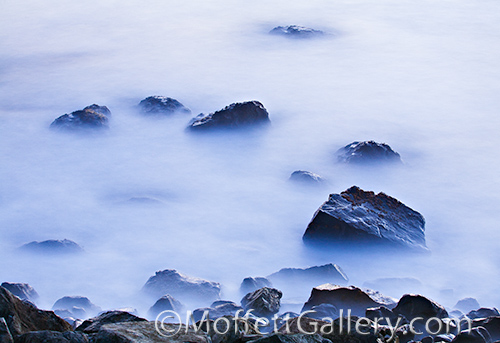
Sea of Mist
I have often said that my favorite time to photograph is just after the sun has set. Well, often I will shoot long after the sun has gone down. This image is one of those times.
It is interesting to me that as many photographers are packing up and going home, I am often just getting started. I like what happens when long exposures capture objects lit with the delicate light coming from the moon. This photograph which is part of my “Shorelines” portfolio, was taken with nearly a 2 minute exposure. The rocks remain tack sharp while the ocean waves crashing ashore become like a sea of mist, soft and delicate. I love how the moisture on the rocks reflects the moonlight and really do look wet, so wet that you can almost feel it when you view the picture. There is also a gentle color shift that I find quite captivating. When I think of the ocean, this is what I see.
If you are a photographer, try not doing a custom white balance sometime. You might just like it! A custom white balance is meant to neutralize the color, making everything look normal, but who is to decide what normal really is. I photograph in this kind of light because of the color, so why would I want to neutralize it? Keeping my white balance in one of the daylight modes will render the colors more closely to how I visualize them instead of removing the color cast caused by the real color of the light that exists, making them appear “normal,” or neutral.












Recent Comments